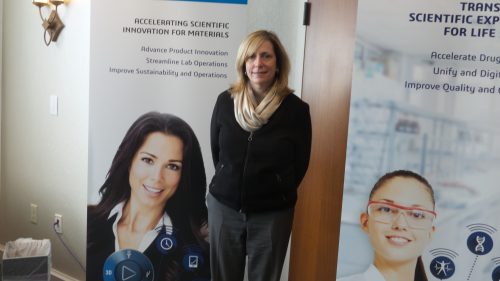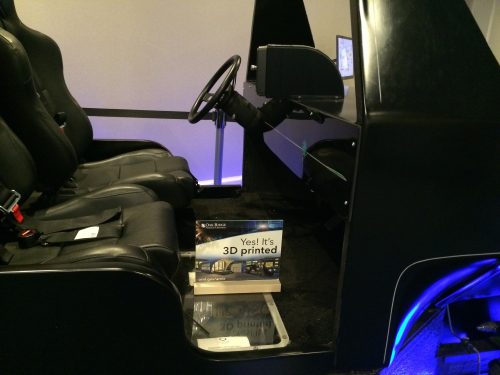"Startup companies are already operating today, for example the Locomotor company that is setting up micro-factories for the production of XNUMXD cars. The customer comes and chooses the car model, color, type of tires, etc., and receives a XNUMXD printed car within six days. It goes without saying that these are electric cars, which do not have an engine with a lot of components."

Additive Manufacturing", the new incarnation of what was known until now as 3D printing, is a developing field. All the time new materials are created and new machines are built. It's a good industry to be in, because it's new and exciting." This is what Renee Richardson, vice president of CATIA systems marketing at Dassault Systèmes, which specializes in XNUMXD imaging XNUMXDEXPERIENCE, said in an interview with the website Hedin and the website CHIPORTAL during the Science in the Age of Experience conference held by Dassault Systèmes last week in Boston.
"In the near future - maybe in 4-5 years, many more components produced in XNUMXD will enter our daily lives, from clothes to shoes. From the industry's point of view, we will see more components produced in Additive Manufacturing for aircraft and cars and used in consumer products."
"The industry has solutions for Additive Manufacturing, and even XNUMXD printing has been around for decades; But they became popular when it was understood the need for dedicated solutions and that these solutions should be built from end to end: start at the molecular level, go to the topology management stage, and end with simulation. All of these should be in the same environment so that later it will also be possible to print its design."

"What is different about us compared to the competitors is that it is not a collection of one-point solutions at each stage, and thus all the wisdom is preserved and integration is made with the IBM planning. Our solution is also linked to the production system, and breaks the barriers between planning, simulation and optimization, when the designer can produce and optimize the component."
One of the attractions of the exhibition adjacent to the Science in the Age of Experience conference was a vehicle that looked like a small truck with a small sign on it - this car was entirely printed with XNUMXD printers. A multidisciplinary team at the Oak Ridge National Laboratory (ORNL) has developed the vehicle that will be able to produce, store and enable energy consumption in areas disconnected from the electricity grid, whether temporarily - due to natural disasters, or for a billion people who are not connected to an electricity grid or whose grid is not reliable
The project Additive Manufacturing Integrated Energy (AMIE) contains innovative experimental systems for the development and demonstration of a mobile energy production unit. The system relies on the developments in the field of XNUMXD printing (Additive Manufacturing) so that you can combine a hybrid vehicle powered by natural gas combined with an electric motor, with a structure designed to produce, consume and store renewable energy. The car will stick to the building and provide it with energy when the other means of energy production will not work due to the lack of sunlight, wind, etc.
This is the third printed vehicle that the lab has revealed in the last year. The first car is a reconstruction of a classic car - a Chevy Corvette to mark its fiftieth birthday, and the second is a military jeep. The building itself will also be built in the same way - Additive Manufacturing.
"Dassault Systèmes is a member of a consortium of companies and academic bodies known as CAFE, whose role is to find ways to reduce the weight of cars in order to reduce fuel consumption. One of the ways to do this is through Additive Manufacturing - XNUMXD printing of composite materials. We provide them with the software (CATIA) that allows them to plan the production of the car from composite materials.
The idea of the project, founded by President Obama, is to develop cheap carbon fiber and reduce the weight of cars. Eventually they will reduce the weight and price so that it will be competitive with the vehicles sold today.
At the end of the chain, Dassault Systèmes does two things: we provide generic file input of the object that is requested to be built in Additive Manufacturing file format. We also work with large printer manufacturers to integrate with their device."
How long will it take for this process to replace the traditional manufacturing process?
Richerson: "There are factories in the aviation sector that are already trying to adopt this in the production of 3D printed components. In the automotive field it will take 5-XNUMX years. Car manufacturers can use solutions like ours to build a model that will integrate with the traditional production process - that is, it will use the same tools. The result may not be an optimal component for Additive Manufacturing, but it will be better than producing the same component using traditional methods.”
"Startup companies are already operating today, for example a company like Locomotor that sets up micro-factories to produce XNUMXD cars. The customer comes and chooses the car model, color, type of tires, etc., and receives a XNUMXD printed car within six days. It goes without saying that these are electric cars, which do not have an engine with many components.
Another company - Jobi Aviation is developing a personal pilot vehicle that will be able to fly a passenger for short distances. She also uses our tools."
In response to the science website's question about how the helicopter would operate in an environment full of aircraft, Richardson said, "They won't be able to fly as high as a helicopter, so not too many regulations will be required."
